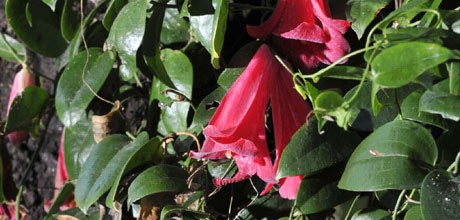Lapageria rosea
This article was first published on 29 Mar 2011.

Lapageria rosea
Climber Benefits from “Summer” Weather
Remember summer? That was the cool windy season with what seemed like almost daily rain from December onwards. However, although it was not much good for organising barbeques, it has given us the best flowering from Lapageria rosea for years.
Lapageria enjoys abundant moisture and usually waits out our drier summers to start flowering in autumn and carry on into winter. This year though, the plants in the Botanic Garden Rhododendron Dell began flowering at the end of January, and by mid March were boasting more blooms than even their normal winter crop.
Lapageria is an ideal woodland garden climber from Chile, commonly known as the Chilean bell-flower. In the Rhododendron Dell they have been planted at the base of trees around the Cherry and Sunken Walk areas which provides the semi-shade they require. Reaching from 4 to 6m, they clothe the trees’ stems with dark green leathery leaves and stiff grey-brown stems.
They are relatively slow growing. One which was cut off at chest height by an over-zealous volunteer about 20 years ago has only recently regained its former stature and capacity to flower well.
The thickly textured bells are pollinated by hummingbirds in the wild so without their help in New Zealand, pollination tends to be haphazard with only a few fruits appearing. Hand-pollination may be needed, or propagate by asexual methods such as taking cuttings or layering.
Look out for the white form, Lapageria rosea var albiflora at the north end of the Sunken Walk, parallel to the Cherry Walk.
Doug Thomson is curator of the Rhododendron Dell at Dunedin Botanic Garden.


